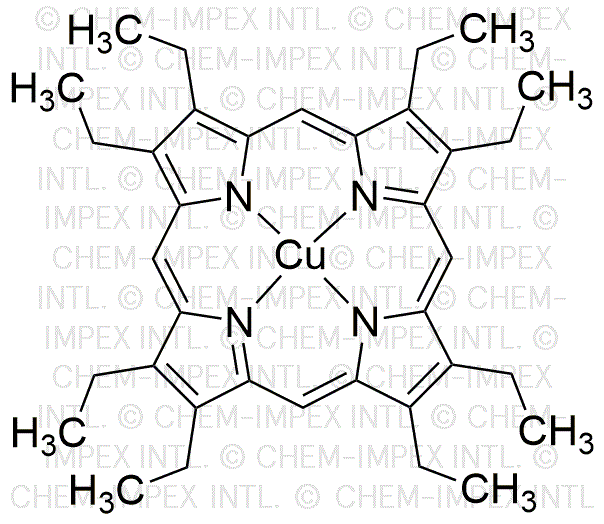Copper(II) 2,3,7,8,12,13,17,18-(octaethyl)porphyrin is widely utilized in research focused on:
- Photodynamic Therapy: This compound is used in medical applications for cancer treatment, where it helps to selectively destroy cancer cells when activated by light, offering a targeted approach compared to traditional therapies.
- Solar Energy Conversion: It plays a crucial role in the development of organic solar cells, enhancing the efficiency of light absorption and energy conversion, making renewable energy sources more viable.
- Electrochemical Sensors: The compound is employed in the creation of sensitive electrochemical sensors for detecting environmental pollutants, providing an effective tool for monitoring air and water quality.
- Catalysis: In chemical reactions, it acts as a catalyst, improving reaction rates and selectivity, which is beneficial in the synthesis of complex organic molecules in the pharmaceutical industry.
- Biochemical Research: It is used as a model compound in studies of metalloporphyrins, aiding researchers in understanding the role of metal ions in biological systems and their potential therapeutic applications.
General Information
Properties
Safety and Regulations
Applications
Copper(II) 2,3,7,8,12,13,17,18-(octaethyl)porphyrin is widely utilized in research focused on:
- Photodynamic Therapy: This compound is used in medical applications for cancer treatment, where it helps to selectively destroy cancer cells when activated by light, offering a targeted approach compared to traditional therapies.
- Solar Energy Conversion: It plays a crucial role in the development of organic solar cells, enhancing the efficiency of light absorption and energy conversion, making renewable energy sources more viable.
- Electrochemical Sensors: The compound is employed in the creation of sensitive electrochemical sensors for detecting environmental pollutants, providing an effective tool for monitoring air and water quality.
- Catalysis: In chemical reactions, it acts as a catalyst, improving reaction rates and selectivity, which is beneficial in the synthesis of complex organic molecules in the pharmaceutical industry.
- Biochemical Research: It is used as a model compound in studies of metalloporphyrins, aiding researchers in understanding the role of metal ions in biological systems and their potential therapeutic applications.
Documents
Safety Data Sheets (SDS)
The SDS provides comprehensive safety information on handling, storage, and disposal of the product.
Product Specification (PS)
The PS provides a comprehensive breakdown of the product’s properties, including chemical composition, physical state, purity, and storage requirements. It also details acceptable quality ranges and the product's intended applications.
Certificates of Analysis (COA)
Search for Certificates of Analysis (COA) by entering the products Lot Number. Lot and Batch Numbers can be found on a product’s label following the words ‘Lot’ or ‘Batch’.
*Catalog Number
*Lot Number
Certificates Of Origin (COO)
This COO confirms the country where the product was manufactured, and also details the materials and components used in it and whether it is derived from natural, synthetic, or other specific sources. This certificate may be required for customs, trade, and regulatory compliance.
*Catalog Number
*Lot Number
Safety Data Sheets (SDS)
The SDS provides comprehensive safety information on handling, storage, and disposal of the product.
DownloadProduct Specification (PS)
The PS provides a comprehensive breakdown of the product’s properties, including chemical composition, physical state, purity, and storage requirements. It also details acceptable quality ranges and the product's intended applications.
DownloadCertificates of Analysis (COA)
Search for Certificates of Analysis (COA) by entering the products Lot Number. Lot and Batch Numbers can be found on a product’s label following the words ‘Lot’ or ‘Batch’.
*Catalog Number
*Lot Number
Certificates Of Origin (COO)
This COO confirms the country where the product was manufactured, and also details the materials and components used in it and whether it is derived from natural, synthetic, or other specific sources. This certificate may be required for customs, trade, and regulatory compliance.


